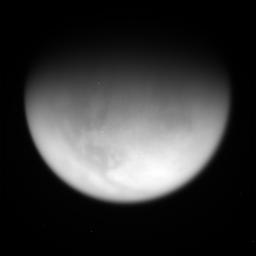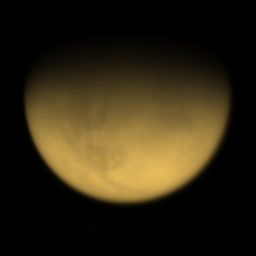June 24, 2023: Titan Is A World Of Mysteries That May Answer Some Fundamental Questions
Titan is not a common moon due to the presence of a thick atmosphere in particular. The largest moon of the Gas Giant Saturn is not a world dominated by craters like Mercury, our moon the Moon, Ceres, Callisto, Tethys, Dione or Rhea. Titan is in fact a giant moon with an active meteorology. The presence of any atmosphere is closely related to the mass of the celestial body and to the environmental temperature at the level of the celestial body. Titan is relatively big and heavy and it evolves at a relatively high distance from the Sun so that it can hold a significant atmosphere. That's not the case for Mercury or the Moon due to the relatively high level of solar energy reaching them in particular. Ganymede, the largest moon of Jupiter and also the largest moon of the Solar System, is devoid of any significant atmosphere curiously. How can we explain that such a massive celestial body is devoid of any significant atmosphere ? The absence of any significant atmosphere on Ganymede must be related to the relatively limited mass of that world at that orbital distance from the Sun or to the relatively high amount of solar energy reaching the giant moon of the Gas Giant Jupiter.
Most moons in the Solar System are devoid of any significant atmosphere. Titan and Triton, the largest moon of Neptune, contain an atmosphere because they present the right combination of mass and environmental temperature for gases like molecular nitrogen to form an atmosphere above the icy or rocky surface. Titan is much lighter than the Earth but the atmospheric pressure on its surface is about 1.5 time higher than the atmospheric pressure on the surface of the Earth at sea level. That seems paradoxical at first sight but the level of solar energy at the level of Titan is so low that gases like molecular nitrogen, methane or argon can remain in the environment of Titan to form a significant atmosphere. Titan looks like the Earth to a certain extent because its atmosphere is dominated by molecular nitrogen which is also the case for the atmosphere of the Blue Planet. Planetologists believe that the Titanian atmosphere looks like the atmosphere of the Early Earth before life emerged and developed. Can molecular nitrogen, methane and the global haze rich in hydrocarbons and organics on Titan interact to engender complex organics or a prebiotic chemistry ?
Planetologists and biologists are particularly interested in the chemistry in the atmosphere and on the surface of Titan because that world contains major ingredients of the life we know. There is a relatively high concentration of methane in the Troposphere of Saturn's largest moon. Methane whose chemical formula is CH4 contains one carbon atom as well as four hydrogen atoms that are key ingredients of water molecules. Methane can interact with nitrogen and with other hydrocarbons or organics to form more complex molecules. Chemical reactions on Titan can be accelerated or boosted by the presence of lakes, seas and rivers on the surface of that enigmatic world. The Cassini orbiter has clearly shown that there are lakes, seas and rivers in the high latitudes of Titan. The lakes, seas and rivers of that giant moon are apparently dominated by methane or ethane. They can undergo evaporation processes and engender clouds that can generate rainfall events like the clouds we regularly encounter in the atmosphere of our own planet. We know the chemistry of water very well but our level of knowledge or understanding of the chemistry of methane is very limited at the present time.
The Earth and Titan are the only worlds in the Solar System that contain stable pools, stable lakes or stable seas. Soon, we will have the opportunity to explore a new type of lake or sea. What will we find in the lakes, seas or rivers of Titan ? Will there be surprises ? Will the chemistry of those lakes or seas help us better understand the chemistry of life in general ? The life we know on Earth is based on liquid water and it mobilizes the carbon element, the hydrogen element, the nitrogen element, the oxygen element, the phosphorus element as well as the sulfur element. Can a lifeform based on liquid methane take shape and develop ? That's a major question that we may answer very soon thanks to the exploration of the lakes, seas and rivers found in the high latitudes of the northern hemisphere of the Orange Moon in particular. Obviously, the presence of a lifeform based on liquid water is ruled out on the surface or in the air on Titan because water can only appear in its solid form on the surface of Titan. If water appears in the form of ice on the surface, how can a lifeform based on liquid water take shape and develop ? That's clearly impossible at first sight !
Can a lifeform based on liquid methane take shape and develop in the humid areas of Titan ? That's really a fundamental question that must be answered and we will soon have the opportunity to answer that question. Titan can make us perform a great leap forward in terms of exobiology ! In the harsh environment of Saturn's largest moon, methane, ethane and propane can appear in their liquid form on the surface. Due to the relatively low environmental temperature at the level of the surface of Titan, chemical reactions must be particularly slow so that any potential lifeform must be relatively simple compared to the typical lifeform based on liquid water we know on Earth. Can we encounter amino acids, proteins, sugars, lipids or a prebiotic chemistry in the humid areas of the Opaque Moon ? We already know that asteroids or comets can contain complex organics like amino acids. Yet, those celestial objects are devoid of any liquid pools. The nature and the dynamics of the lakes, seas and rivers of Titan are also major questions. Researchers anticipate that the lakes, seas or rivers found in the north polar region of the giant moon must be dominated by methane and ethane and must contain dissolved nitrogen as well.
The major pools of liquid found in the northern hemisphere must be really fascinating and impressive. Kraken Mare is the largest pool or sea on Titan and that sea contains islands like on Earth. Networks of drainage channels connected to Kraken Mare or Ligeia Mare can be clearly seen in the radar views obtained from the Cassini orbiter. A parallel between the structure and the dynamics of the hydrological systems found on the surface of the Earth and on the surface of Titan can be drawn. How can we explain that the lakes, seas and rivers on Titan are concentrated in the high latitudes of each hemisphere ? How can we explain the dichotomy between the north polar region and the south polar region on Titan ? Why are the lakes, seas and rivers mostly concentrated in the high latitudes of the northern hemisphere on Titan ? Is there a layer of liquid methane or liquid ethane beneath the crust of the region of lakes, seas and rivers in the northern hemisphere ? Thanks to the Cassini orbiter in particular, we have been in a position to gather a significant amount of data regarding the climate and the meteorology of Titan. However, the puzzle regarding the climate and the meteorology of Titan is far from being complete.
Ideally, we should study the atmosphere of Titan for a full Titanian year that is to say for almost 30 Terrestrial years. During its long mission in the Saturn System, the Cassini orbiter had only collected data regarding Titan from 2004 to 2017 which is less than half a Titanian year. We have clearly seen seasonal changes on Titan from the start of the mission in the Saturn System to the end of the mission of the Cassini orbiter in the Saturn System when it plunged into the atmosphere of the Gas Giant Saturn. When the Cassini-Huygens spacecraft arrived in 2004, the northern hemisphere of the Opaque Moon was experiencing the Winter season whereas the southern hemisphere was experiencing the Summer season. At the end of the mission of the Cassini orbiter in the Saturn System, the northern hemisphere was experiencing the start of the Summer season whereas the southern hemisphere was experiencing the start of the Winter season. The size and the level of some lakes or seas found in the north polar region or found in the south polar region must have changed due to seasonal factors. Researchers try to clearly identify the cycle of methane in the atmosphere of Titan and between the ground, the underground, the Troposphere or the Stratosphere.
The origin, the dynamics and the fate of Titan are obviously major questions that are likely to help us better understand the evolution of our own planet. Will the Titanian atmosphere remain stable over time ? Will it disappear ? The diversity of the atmospheres in the Solar System is remarkable. Small worlds like Pluto or Triton can hold relatively thin atmospheres whereas larger worlds like Ganymede are unable to retain any significant atmosphere. Multiple factors regarding the stability of atmospheres must be taken into account. Solar winds must play a relatively significant role for Mercury for instance. The strength of the environmental magnetic field must also be taken into account for moons like Io, Europa, Ganymede or Callisto for instance. The exploration of the Solar System reveals that small worlds can be remarkably active. That's the case for Enceladus that may contain a subsurface ocean rich in liquid water. That's also the case for Triton or Pluto that may undergo strong cryovolcanic events from time to time. Tethys, Dione, Rhea, Titan or Europa are among those worlds of the Solar System that may contain a subsurface ocean rich in liquid water. The contact of the presumed subsurface ocean with the presumed rocky core can enrich the ocean with key elements, molecules or ingredients for the development of life.
- To get further information on that news, go to: https://solarsystem.nasa.gov/news/911/10-things-unsolved-mysteries-of-saturns-moons/.

